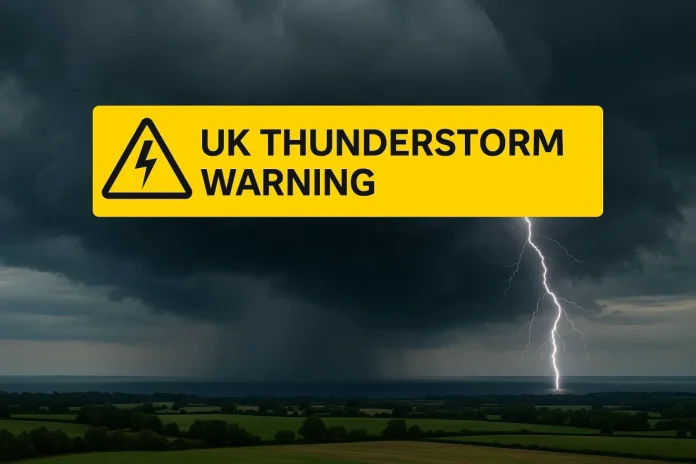Thunderstorms in the UK can be both thrilling and dangerous, especially for international students who may not be familiar with the risks associated with extreme weather conditions. While weather alerts UK and UK thunderstorm warnings aim to protect the public, it is vital for students to understand the hazards involved when severe weather strikes. Whether you’re residing in student accommodation in Leeds, Manchester, or London, the consequences of getting caught outdoors during a storm can be dire.
For students living in student housing, such as student apartments or student rooms, knowing what to avoid during a thunderstorm can make a significant difference in your safety. The UK thunderstorm warning system, administered by the Met Office, issues important warnings related to weather warning thunderstorms, including details about UK lightning maps, UK wind warnings, and storm warnings UK. These warnings highlight the importance of staying informed and taking necessary precautions when storms approach.
In this article, we will explore 10 things students should avoid doing outdoors during a thunderstorm to ensure safety. By understanding these precautions, students can make smarter choices and stay safe during unpredictable weather conditions in the UK.
UK Thunderstorm Warning
In the UK, a thunderstorm warning UK is part of the country’s systematic approach to managing severe weather and minimizing the risks associated with lightning, flooding, and strong winds. The Met Office thunderstorm warning provides students and the general public with real-time updates about weather conditions, including UK storm trackers, UK severe weather warnings, and flood warnings UK. For students, especially those in student accommodation or student housing near rivers or flood-prone areas, being aware of these warnings is crucial for safety.
Thunderstorms in the UK are not uncommon, especially during the warmer months, and they can cause sudden flooding, dangerous winds, and the risk of lightning strikes in the UK. For students in student rooms or student apartments, a sudden storm could potentially disrupt both their academic and social lives, but knowing how to stay prepared can make all the difference.
The UK emergency alert system ensures that students are alerted to these dangerous conditions. It’s essential for students to keep an eye on weather forecasts, especially if they live in areas with high storm risk. Monitoring weather alerts UK or using the UK lightning map and UK storm tracker will help students stay informed and ready for any incoming storms.
10 Things Students Should Avoid Doing Outdoors During a Thunderstorm
While thunderstorms can often seem exciting, they come with serious risks. Here are 10 things students should avoid doing outdoors during a thunderstorm to stay safe and minimize the risks of injury or property damage.
Avoid Standing Under Trees
One of the most dangerous places to be during a thunderstorm is standing under a tree. Lightning strikes UK are far more likely to hit tall structures like trees, and the electrical charge can travel through the ground, potentially causing severe injuries or even fatalities.
- Why Students Should Avoid It: Students living near parks or open spaces should avoid taking shelter under trees, especially during a UK weather warning thunderstorms. Instead, seek indoor shelter or a sturdy structure to stay safe.
Don’t Stay Near Water Bodies
Thunderstorms are notorious for causing flash floods, which can be extremely dangerous, especially near bodies of water like rivers, lakes, or streams. With the UK lightning map showing heightened activity during storms, the risk of flooding increases, making it hazardous to stay near water.
- Why Students Should Avoid It: If you live in student accommodation near rivers or water bodies, it’s essential to stay indoors during a UK weather warning thunderstorms. Water can rise rapidly, and flash floods can overwhelm areas in a short period, posing a significant risk to safety.
Yout should not Use Electrical Appliances Outdoors
Using electrical appliances or electronic devices outdoors during a thunderstorm is dangerous. Lightning strikes in the UK can cause power surges, which may damage electronic devices or, even worse, lead to electrical shock if you’re holding a device. It’s crucial to avoid any electronics while outside in a storm.
- Why Students Should Avoid It: If you’re in student rooms or student apartments, avoid charging your devices or using any electrical appliances outdoors. Even small gadgets like phones and laptops can become hazards in a storm. Unplug devices to prevent any risk of damage or electrocution.
Students should Avoid Driving or Cycling
While it may seem tempting to ride out a storm by driving or cycling to your student accommodation or university, it is dangerous to do so. UK wind warnings often accompany thunderstorm warnings, making roads slippery and visibility poor. The heavy rain, gusty winds, and reduced visibility make driving or cycling incredibly risky.
- Why Students Should Avoid It: During a storm warning UK, stay off the roads and avoid using personal transport. Instead, opt for public transportation, which is generally safer and better equipped for stormy conditions. Check UK weather forecasts for any alerts before considering travel.
Don’t Stand Near Windows
Windows are particularly vulnerable during a thunderstorm, as strong winds and flying debris can easily break glass. If you’re in a high-rise student apartment or a student room, it’s best to stay away from windows during a storm, especially if a UK severe weather warning has been issued.
- Why Students Should Avoid It: For students in student housing with large windows, it’s safest to move to an interior room and stay away from any glass areas. The risks of flying glass and debris from wind damage should not be underestimated.
Students should not Ignore Storm Warnings
Ignoring official weather alerts UK or thunderstorm warnings UK can be incredibly dangerous. Always pay attention to the UK emergency alert system, which provides real-time information on the severity of storms, including lightning risks and wind conditions. Following the advice of local authorities is key to ensuring your safety during severe weather.
- Why Students Should Avoid It: Emergency preparedness UK is crucial. Ignoring warnings or failing to act can lead to accidents or damage. Make sure to monitor UK storm trackers and adhere to the instructions given by local authorities.
Avoid Large Open Areas
When thunderstorms strike, large open areas like fields, car parks, or sports grounds become extremely dangerous. Lightning is more likely to strike open areas with no shelter, putting anyone caught outside at risk.
- Why Students Should Avoid It: Stay inside or seek shelter in a sturdy, enclosed structure during a thunderstorm. Avoid being out in open areas, such as university sports fields or outdoor events, when a thunderstorm warning UK is in effect.
Don’t Take Shelter in a Tent
While tents might seem like a convenient place to shelter from a storm, they provide no protection from lightning, and strong winds can easily destroy them. It’s never safe to stay in a tent during a storm warning UK.
- Why Students Should Avoid It: If you’re camping or attending outdoor events, head indoors as soon as a UK weather warning thunderstorms is issued. Tents are no match for the power of a thunderstorm.
Students should Avoid Swimming in Pools
Swimming pools can be deadly during a thunderstorm due to the risks posed by lightning strikes UK. Water conducts electricity, and a strike can cause widespread harm to anyone in the pool.
- Why Students Should Avoid It: For students who live in student housing with pool access, it’s essential to avoid swimming during a storm. Always stay indoors during weather warning thunderstorms, as water poses a direct threat during electrical storms.
Don’t Wait Until the Last Minute to Take Shelter
Procrastinating when a storm is approaching can put you in a dangerous situation. Always seek shelter as soon as a UK weather warning is issued to avoid being caught in severe weather like flooding, wind damage, or lightning strikes.
- Why Students Should Avoid It: Acting promptly during a UK thunderstorm warning is crucial. If you wait until the last minute, you may find it difficult to reach safe shelter or avoid hazardous conditions.
Conclusion
Thunderstorms are not to be taken lightly, especially for students in the UK. Understanding the UK thunderstorm warning system and being aware of the risks associated with outdoor activities during a storm is essential for staying safe. Always monitor weather alerts UK and follow the advice provided by the Met Office Thunderstorm warning system.
If you’re living in student accommodation in cities like Manchester, Leeds or London, it’s vital to be aware of your surroundings and stay informed about the potential risks. Students in student rooms or student apartments should avoid outdoor activities such as standing under trees, staying near water, or using electrical appliances during a storm.
For those in need of well-located student housing, Uninist offers a range of high-quality, safe, and well-connected accommodations in major cities across the UK. Whether you’re in need of short-term student accommodation or long-term housing, Uninist ensures you’re in a safe environment even when severe weather strikes. Stay safe, stay informed, and make the most of your university experience!
FAQ
What should students avoid doing outdoors during a thunderstorm in the UK?
Students should avoid standing under trees, being near water bodies, using electrical devices outdoors, driving or cycling, and staying in tents during thunderstorms. Always seek shelter indoors.
How can I stay informed about thunderstorms in the UK?
You can stay informed by following UK weather alerts, Met Office thunderstorm warnings, and checking the UK lightning map for real-time updates. The UK emergency alert system also notifies the public during severe weather.
What are the risks of standing under trees during a thunderstorm?
Trees are common targets for lightning strikes, and being near them can put you at risk of being struck by lightning or injured by falling debris.
Why should I avoid using electrical appliances outdoors during a storm?
Lightning strikes in the UK can cause power surges that may damage electronic devices or cause electric shocks if you are holding them outdoors. Always stay indoors when storms are forecasted.
Is it safe to swim in a pool during a thunderstorm?
No, it is unsafe to swim during a thunderstorm. Water is a conductor of electricity, and lightning strikes UK can cause severe harm if you’re in the pool.
Can I still drive during a UK thunderstorm warning?
It’s advised to avoid driving during a storm warning UK as heavy rain, strong winds, and reduced visibility can make roads dangerous. Opt for public transport instead.
What should I do if I’m caught outdoors during a thunderstorm?
Immediately seek shelter indoors or in a sturdy structure, away from windows, trees, and water bodies. Avoid open fields and tall objects during weather warning thunderstorms.
How does the UK emergency alert system help students?
The UK emergency alert system provides real-time notifications about severe weather, including thunderstorms, allowing students to take necessary precautions and stay safe.
What is the best way to monitor thunderstorm warnings?
Use apps like the UK storm tracker, check Met Office thunderstorm warnings, and monitor local weather forecasts UK for up-to-date information on storm severity.
How can Uninist help students during thunderstorms?
Uninist offers student accommodation in safe areas near universities, ensuring students have access to shelters in case of a thunderstorm warning UK. You can also rely on Uninist for reliable housing near public transport and emergency services.

